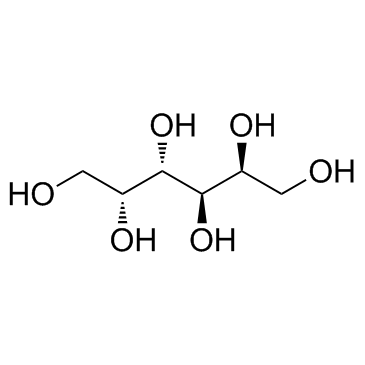Dulcitol

Dulcitol structure
|
Common Name | Dulcitol | ||
|---|---|---|---|---|
| CAS Number | 608-66-2 | Molecular Weight | 182.172 | |
| Density | 1.6±0.1 g/cm3 | Boiling Point | 494.9±0.0 °C at 760 mmHg | |
| Molecular Formula | C6H14O6 | Melting Point | 188-189ºC | |
| MSDS | Chinese USA | Flash Point | 292.5±23.3 °C | |
|
Detection of autosomal dominant polycystic kidney disease by NMR spectroscopic fingerprinting of urine.
Kidney Int. 79(11) , 1244-53, (2011) Autosomal dominant polycystic kidney disease (ADPKD) is a frequent cause of kidney failure; however, urinary biomarkers for the disease are lacking. In a step towards identifying such markers, we used multidimensional-multinuclear nuclear magnetic resonance (... |
|
|
Leaf-cutter ant fungus gardens are biphasic mixed microbial bioreactors that convert plant biomass to polyols with biotechnological applications.
Appl. Environ. Microbiol. 81 , 4525-35, (2015) Leaf-cutter ants use plant matter to culture the obligate mutualistic basidiomycete Leucoagaricus gongylophorus. This fungus mediates ant nutrition on plant resources. Furthermore, other microbes living in the fungus garden might also contribute to plant dige... |
|
|
Diagnostic use of cerebral and extracerebral oxysterols.
Clin. Chem. Lab Med. 42(2) , 186-91, (2004) 24S-Hydroxycholesterol (24OHC) and 27-hydroxycholesterol (27OHC) are two structurally similar oxysterols of different origins--the former almost exclusively formed in the brain and the latter formed to a lesser extent in the brain than in most other organs. H... |
|
|
The effect of increased concentrations of homocysteine on the concentration of (E)-4-hydroxy-2-nonenal in the plasma and cerebrospinal fluid of patients with Alzheimer's disease.
Neurobiol. Aging 23(3) , 383-8, (2002) There is evidence that increased blood concentrations of homocysteine may be a risk factor for Alzheimer's disease. (E)-4-hydroxy-2-nonenal (HNE) is a neurotoxic product of lipid peroxidation that is increased in the ventricular fluid and brains of patients w... |
|
|
Cerebrospinal fluid and plasma distribution of myo-inositol and other polyols in Alzheimer disease.
Clin. Chem. 42(2) , 298-302, (1996) Previous studies suggest the presence of increased concentrations of cerebral myo-inositol in Alzheimer disease (AD). To characterize this abnormality further, we quantified myo-inositol and several other polyols in cerebrospinal fluid (CSF) and plasma from 1... |
|
|
Pentosidine and N(epsilon)-(carboxymethyl)-lysine in Alzheimer's disease and vascular dementia.
Neurobiol. Aging 24(2) , 333-8, (2003) Increasing evidence suggests an interaction of oxidative stress and the formation of advanced glycation end products (AGE) in the onset and progression of Alzheimer's disease. We studied levels of pentosidine and N(epsilon)-(carboxymethyl)-lysine (CML) in ser... |
|
|
Ratio of 8-hydroxyguanine in intact DNA to free 8-hydroxyguanine is increased in Alzheimer disease ventricular cerebrospinal fluid.
Arch. Neurol. 58(3) , 392-6, (2001) Markers of oxidative stress are increased in cerebrospinal fluid (CSF) of patients with Alzheimer disease (AD), although none of those reported are appropriate diagnostic markers because of the overlap between patients with AD and control subjects.To determin... |
|
|
Patterns of cerebrospinal fluid catechols support increased central noradrenergic responsiveness in aging and Alzheimer's disease.
Biol. Psychiatry 46(6) , 756-65, (1999) High cerebrospinal fluid (CSF) norepinephrine (NE) concentrations in aging and Alzheimer's disease (AD) could reflect decreased NE clearance from central nervous system (CNS) extracellular fluid or increased release of NE into CNS extracellular fluid. Measuri... |
|
|
Glycerophosphocholine is elevated in cerebrospinal fluid of Alzheimer patients.
Neurobiol. Aging 25(10) , 1299-303, (2004) Experimental and clinical studies give evidence for breakdown of membrane phospholipids during neurodegeneration. In the present study, we measured the levels of glycerophosphocholine (GPCh), phosphocholine (PCh), and choline, that is, water-soluble metabolit... |
|
|
Homocysteine and methylmalonic acid concentrations in cerebrospinal fluid: relation with age and Alzheimer's disease.
J. Neurol. Neurosurg. Psychiatr. 76(11) , 1585-7, (2005) Homocysteine may be involved in the pathogenesis of late onset Alzheimer's disease. It is implicated in the metabolism of several important pathways in the brain. Methylmalonic acid (MMA) is related to the metabolism of branched chained amino acids and fatty ... |